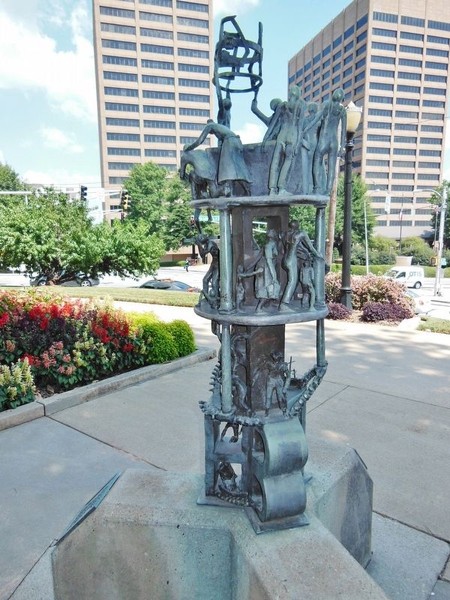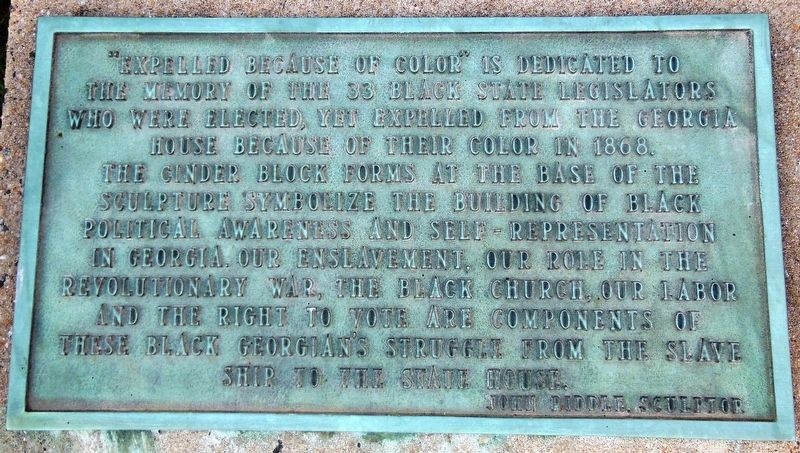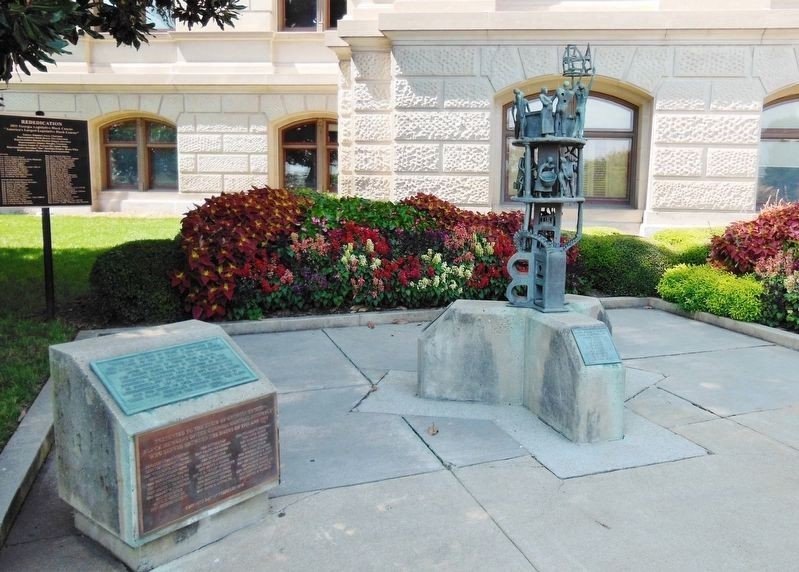"Expelled Because of Color" Historical Marker and Sculpture
Introduction
Text-to-speech Audio
Images
Photograph of sculpture.

List of names of the expelled members.

Photograph of the historical marker.

Photograph of historical marker, dedication plaque, and statue.

Backstory and Context
Text-to-speech Audio
The "Expelled Because of Color" historical marker and statue is dedicated to the 33 African American state legislators who were elected and then forced to leave the Georgia House in 1868 because they were African American. There is also a dedication panel that was presented to the State of Georgia by the African American members of the Georgia General Assembly who served between 1963 and 1978. It was dedicated on February 16, 1978. The sculpture that accompanies the historical marker and dedication panel was created by John Riddle. Riddle said that the cinder block base symbolizes the building of Black political awareness. Enslavement, role in the Revolutionary War, the Black church, labor, and the right to vote are also components of "the Black Georgian's struggle from the slave ship to the State House."1
Prior to the election of 1868, white Democrats and some white Republicans argued that the Georgia Constitution did not guarantee the right for African Americans to hold positions in office. A clause that guaranteed the right was defeated. Some African American voters even voted against the clause because "had been assured by white leadership of the Republican Party that Blacks were eligible to hold office and that a special provision was unnecessary."2 In the April 1868 election, 25 African Americans were elected to the House and three more to the Senate. After Georgia was readmitted to the Union in June 1868, white Democrats wanted to exclude African Americans and replace them with their losing opponents. By September 1868, Democrats secured enough Republican support to pass a resolution that excluded African Americans from the House and the Senate. It was done on the grounds that African Americans were "ineligible" to serve under the Constitution.
After African Americans were removed from office, Democrats gained control of the House. Republicans kept control of the Senate but sided with Democrats on issues surrounding race. In November 1868, Democrats run on a platform of white supremacy, which increased violence around Georgia. The Democrats used terror and intimidation, as well as the Ku Klux Klan. Georgia, in response, was placed under military supervision, and Congress did not seat Georgian representatives. African American legislators continued to lobby the federal government to reseat the legislators. The federal government ordered the Georgian government to restore the African American legislators' seats. It was not until 1870 that the seats were restored. Twenty-two Democrats who held public office before the war and were military officers under the Confederacy were disqualified. This meant that control of the House returned to Republicans.
Thanks to federal intervention and the presence of the U.S. Army during this phase of Reconstruction, the legally-elected African American representatives eventually had their seats restored. It is worth noting that a significant number of African Americans also won local elections throughout the South from the late 1860s to the early 1870s until white supremacists once again secured political control during the final years of Reconstruction.
Cite This Entry
Stanley, Mallory, Tristin Milazzo, and Clio Admin. ""Expelled Because of Color" Historical Marker and Sculpture ." Clio: Your Guide to History. January 4, 2021. Accessed April 21, 2025. https://theclio.com/entry/93166
Sources
1 Mariner, Cosmos . "Expelled Because of Color", The Historical Marker Database. March 2nd 2019. Accessed December 31st 2019. https://www.hmdb.org/m.asp?m=130191.
2 McDonald, Laughlin. A Voting Rights Odyssey: Black Enfranchisement in Georgia. Cambridge, UK. Cambridge University Press, 2003.
3 Drago, Edmund L. Black Legislators during Reconstruction, New Georgia Encyclopedia. September 5th 2002. Accessed January 1st 2020. https://www.georgiaencyclopedia.org/articles/history-archaeology/Black-legislators-during-reconstruction.

